Should You Protect Your Dog From Ticks in Washington State?
Although ticks are not as prevalent as they are on the east coast, protecting your dog from ticks in Washington state is still important.
Tick bites used to only be a concern if you lived on the east side of Washington State, where ticks have always been encountered regularly, but that has changed in the last decade.
Now, you have to be cautious no matter where in the state you are.

I grew up in Western Washington and only saw one tick on my dog as a kid. And we spent a lot of time playing outdoors and in the woods.
Then, about 10 years ago, my dog got bit by a tick in one of Seattle’s urban parks.
Since then, I’ve seen an increasing number of people in Western Washington reporting ticks on their dog.
Since I have lived in Washington State for decades, and have been hiking with my dogs here for 20 years, I know the history of ticks in our state and how they have spread as well as the local risks.
In this article, I will share what I know in hopes of helping those that just moved here or are visiting from another area.
Why You Need to Protect Your Dog From Ticks
In addition to ticks being really creepy and gross, a tick bite can be dangerous.
Ticks carry many diseases that they can pass along to humans and animals.
Fortunately, in comparison to other regions of the United States, relatively few tick-borne disease cases are reported each year in the Pacific Northwest.
According to the Washington State Department of Health (DOH), ticks in Washington State can spread diseases such as:
- Lyme Disease
- Anaplasmosis
- Tick-borne Relapsing Fever
- Rocky Mountain Spotted Fever
- Tick Paralysis
- Tularemia
- Babesiosis
- Ehrlichiosis
Of the tick borne diseases above known to be present in Washington State, the only ones found in humans, who have not been exposed to ticks outside of Washington State, are babesiosis, lyme disease, tick-borne relapsing fever, Rocky Mountain Spotted Fever, and Tularemia.
Reported information for dogs and tick-bourne diseases in Washington State is sparse.
Note: this could have more to do with the fact that Canine Lyme borreliosis is not a reportable disease than actual number cases.
This Seattle government document only calls out Lyme disease and Anaplasmosis (bolded above) as being detected in dogs in Washington State.
In addition, s 2021 article by an Everett, WA veterinarian says that the most common tick-borne diseases diagnosed in dogs in the Pacific Northwest include Canine Bartonellosis (this wasn’t listed on the WA DOH Website, is very rare, and this is the only mention I’ve seen of it so it’s not on the list above), Lyme Disease, Anaplasmosis, Ehrlichiosis and Rocky Mountain Spotted Fever.
I couldn’t find any cases of tick paralysis in dogs in Washington State but several cases are found in llamas and alpacas each year in Washington State (source).
The bottom line is that a dog in Washington State can potentially contract any of the above tick-bourne diseases but they’re rare.
For more details about the diseases listed above, check out the Washington State Department of Health website.
Lyme Disease in Washington State
Even though I touched on Lyme disease above, I want to provide more information about it since it’s the most prevalent tick borne disease in the United States and the one people fear the most.
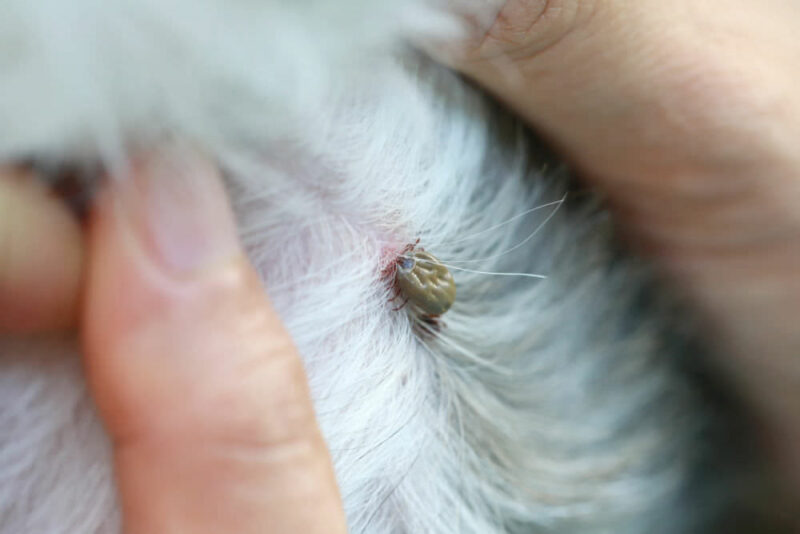
You probably wonder if Washington State has ticks with Lyme disease.
The answer is definitely yes, although the reports of Lyme disease in dogs in Washington State are drastically lower than in some areas of the country like the east coast.
Each year, only 0-7 confirmed Lyme disease cases per year are reported to be acquired in Washington in humans (source).
Yes, I know this is human cases, and the numbers for dogs could vary, but like I said above, I can’t find specific reported numbers for dogs in Washington State despite hours of research.
Based on the lack of information provided in this dog loving state (some might say dog obsessed), and what my vet has told me in the past, the number of case numbers of Lyme disease in dogs in Washington are also very low.
To back this statement, this ticks in Seattle article by a local veterinarian, M. Donovan, says, “We have all heard of Lyme disease, which is relatively rare here…”
The article above was written in 2018 though so it is possible that the cases of Lyme disease in dogs in Washington State have increased by then.
However, there has not been an explosion of cases so the numbers are still relatively low.
Note: Humans bitten by ticks in Washington State are more likely to contract tick-borne relapsing fever in Washington State than Lyme Disease.
Interestingly enough, although there are fewer ticks in Western Washington, this King County Lyme Disease information page says,
“In Washington state [Lyme disease] occurs primarily in the western half of the state.”
My guess is because the deer tick is the most common on the west side of the state and also the most common tick in Washington to transmit Lyme disease (see the section below).
Two very important things to know about Lyme disease are:
- A tick must bite an animal to transmit Lyme disease
- In most cases, a tick must be attached for 36 to 48 hours in order to transmit Lyme disease (source) and have “taken a blood meal”.
That means if you find a tick on your dog that has not bit them yet, the chance of transmitting Lyme disease is zero.
If a tick hasn’t sucked blood from your dog yet (as evidenced by its swollen body), and/or you know it hasn’t been attached for over 24 hours, it’s very unlikely to impossible that your dog will contract Lyme disease.
Read below to see which Washington State ticks are most likely to transmit Lyme disease to your dog if bitten.
What Kind of Ticks May Bite Your Dog in Washington State?
There are 4 species of ticks commonly found in Washington State.
Western Black Legged Tick
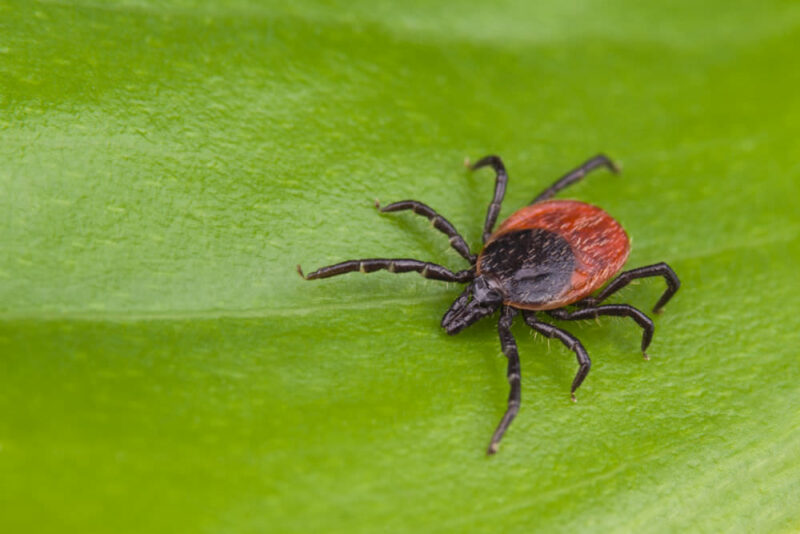
Western black-legged ticks (also called deer ticks) are mainly found in Western Washington, and along the eastern slopes of the Cascade Mountains, in forested or brushy areas.
This tick is most easily identified by its reddish-orange body, black shield and dark black legs
Western black-legged ticks can transmit Lyme disease. They can also transmit Anaplasmosis.
Western Dog Tick
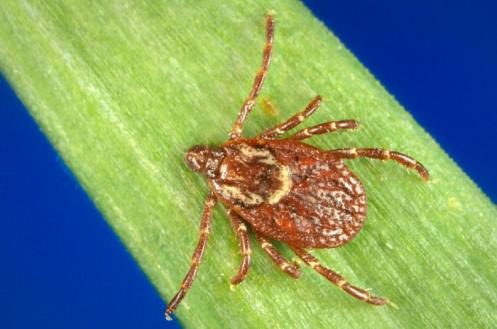
The Western Dog Tick, sometimes also referred to as the American Dog Tick, can be found all over Washington, but is found primarily in eastern Washington and parts of southwest Washington.
The American dog tick have a dark brown body. Females have an off-white shield, while adult males look more mottled.
They prefer woodland areas, medium height grasses and shrubs between wetlands and woods, and sunny or open areas around woods.
It’s common to find larvae and nymphs (very tiny, early stages) of these ticks on your dog.
The American Dog Tick transmits Tularemia and Rocky Mountain spotted fever.
Rocky Mountain Wood Tick
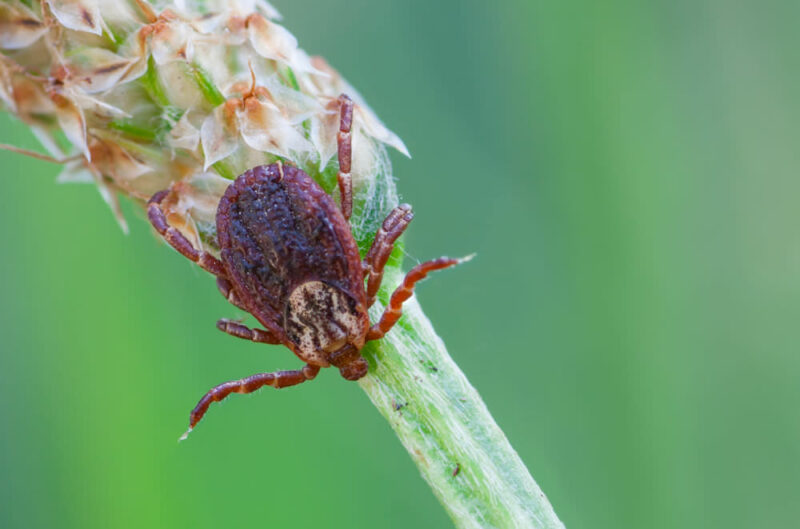
The Rocky Mountain Wood Tick is found primarily on the eastern side of Washington State. They look very similar to American Dog ticks.
They prefer woodland areas, medium height grasses and shrubs between wetlands and woods, and sunny or open areas along the edge of woods.
Rocky Mountain Wood ticks can transmit Rocky Mountain spotted fever and tularemia.
Soft Tick
Soft ticks are primarily encountered when sleeping in rustic cabins or yurts in mountainous areas where rodent encounters are common.
Soft ticks do not have a hard shell and are shaped like a large raisin.
Soft ticks can transmit tick-borne relapsing fever.
Because soft ticks usually feed at night. Because the bites are quick and painless, and they remain attached for a very short time, most people never realize a tick bit them.
Although the Washington State Department of Health does not list it as a common Washington State tick on their website, I have also found evidence that Brown Dog ticks are also found in Washington.
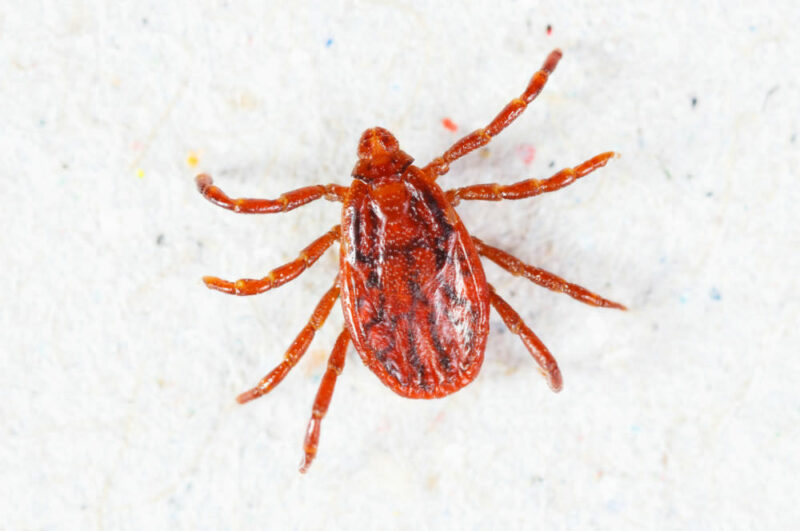
The brown dog tick is a reddish brown with a narrow shape in comparison to other ticks and does not have a shield/disk near the head.
The Brown Dog tick can transmit Rocky Mountain spotted fever.
*the information above was compiled from the Washington State Department of Health, LymeDisease.org, and the CDC.
Of the ticks listed above, the most common ticks on dogs in Washington State are the Black Legged Tick (Deer Tick), Rocky Mountain wood tick, and American Dog Tick.
Please not that individual ticks within a species may look diferent depending on life stage and gener. For more tick photos, see HERE and HERE.
How Bad Are Ticks in Washington State?
Ticks definitely live in Washington State. How bad they are depends on where in the state you are looking though.
Although they have been found on dogs and people, and the incidence is increasing, ticks are not common in Western Washington.
I would say ticks are not bad in Western Washington and I feel very safe there without tick protection.
Ticks are very common in central and eastern Washington though.
Although there is less of a problem with ticks as on the east coast, it’s still important to assume you or your dog may pick up a tick when hiking these areas and take precautions.
Tick season in Washington State is spring through summer into early fall (Apri-September). This is when ticks are abundant in central and eastern Washington.
Just because this is the most common time to find them, doesn’t mean your dog can’t pick up a tick at other times of the year though, especially in Western Washington where winter temperatures are more mild.
How To Protect Your Dog From Ticks
Disclosure: Some of the links in this article are affiliate links (Amazon Associate or other programs we participate in). As an affiliate, I earn a small commission from qualifying purchases.
Tick prevention is the best way to guard you and your dog from contracting tick-borne diseases.
A tick can only transmit the disease if they bite so keeping them off of your dog is key.
To minimize the chance of your dog picking up, or getting bitten by, ticks:
- Keep them on the trail and out of the brush
- Check them thoroughly for ticks during your hike, once you return to the car, and when you return home
- Use a monthly topical, or chewable, flea and tick preventative
- Spray them down with a pet-safe insect repellent in addition (optional)
- Tie an insect repellent bandana around their neck to blog the scruffy fur on the back of their neck where ticks like to burrow
I always do the first three of these with my dog during tick season.
You can read my 5-part system for protecting my dogs from ticks HERE.
When I check my dog for ticks, I feel all over the body with my fingers.
I concentrate on the areas where ticks are most likely to hide like back of neck, inside ears, between paw pads, in arm pits, and in the groin area (think dark and warm).

My favorite tick repellants are Vectra 3D (read my Vectra review here) and K9 Advantix II because they actually repel ticks (most only kill them after biting) and they work on several different species of ticks (most only protect from one).
The insect repellent bandana offers a little extra protection for one of the ticks favorite hiding places – the back of the neck – but sometimes the weather is too hot for my dogs to wear one.
What To Do If Your Dog Gets Bit By A Tick
If you find a tick attached to your dog, don’t panic.
You can choose to go to the vet but you don’t have to (go if you are at all concerned though).
Remove the tick using a pair of tweezers like the TickEase Dual-Tipped Tick Remover Tweezers.
DO NOT burn it, twist it, or smother it; that can cause it to spit more saliva into your dog, which carries any diseases a tick may have.
Watch this video for the proper way to remove a tick.
It’s always a good idea to wipe the bite area with alcohol to sterilize it after the tick has been removed.
If you try to remove the tick but the head is still stuck in your dog, read about my experience here.
Place the tick in a sealed container and put it in the freezer to kill it.
Keep the tick for at least a couple of weeks while you keep an eye out for any signs and symptoms of lyme disease or illness.
Pay attention to how your dog is acting and call your vet immediately if you see signs that your dog might not be feeling well.
By keeping the tick, you can also inspect it closer and use this tick identification guide to help identify what type it is, send some information and a picture to Tick Spotters for identification, or mail it to a laboratory that does tick testing and identification.
Knowing what type of tick you or your dog were bitten by can tell you what common diseases that species of tick carries in your area.
Common Questions about Ticks in the Pacific Northwest
Below are some common questions people ask regarding ticks in Washington State and the Pacific Northwest.
Can Dogs get ticks in Washington?
In this article, we have established the answer to this question is yes.
In my experience, a dog is more likely to get ticks on them than humans.
Reasons for this include:
- Complacency of the owner when it comes to tick protection for their dog
- The fact that humans can cover most of our body with clothing to prevent ticks from getting on us
- Because dogs are more likely to wander off trail and through the brush or grass
- Dog hair has a tendency to “comp” ticks off of vegetation.
Are ticks common in the Pacific Northwest?
In many areas west of the Cascade Mountains, it is common to encounter ticks.
Tick sightings are significantly less on the west side of the Cascade Mountains along the Pacific Coast but they are present and the number of sightings has increased significantly in the last 10 years.
Does Washington State have a tick problem?
Are ticks present in Washington? Yes.
Does this pose a “problem”? Yes, in the sense that no one likes to discover these nasty blood suckers on themselves or their dog nor do they want to get sick from being bit.
Whether ticks are considered a problem in Washington State is all relative though.
I would consider the prevalence of ticks, and Lyme Disease, on the East coast a problem.
Because cases of tick-borne diseases in Washington State are significantly less, personally I would not say Washington has a “tick problem”.
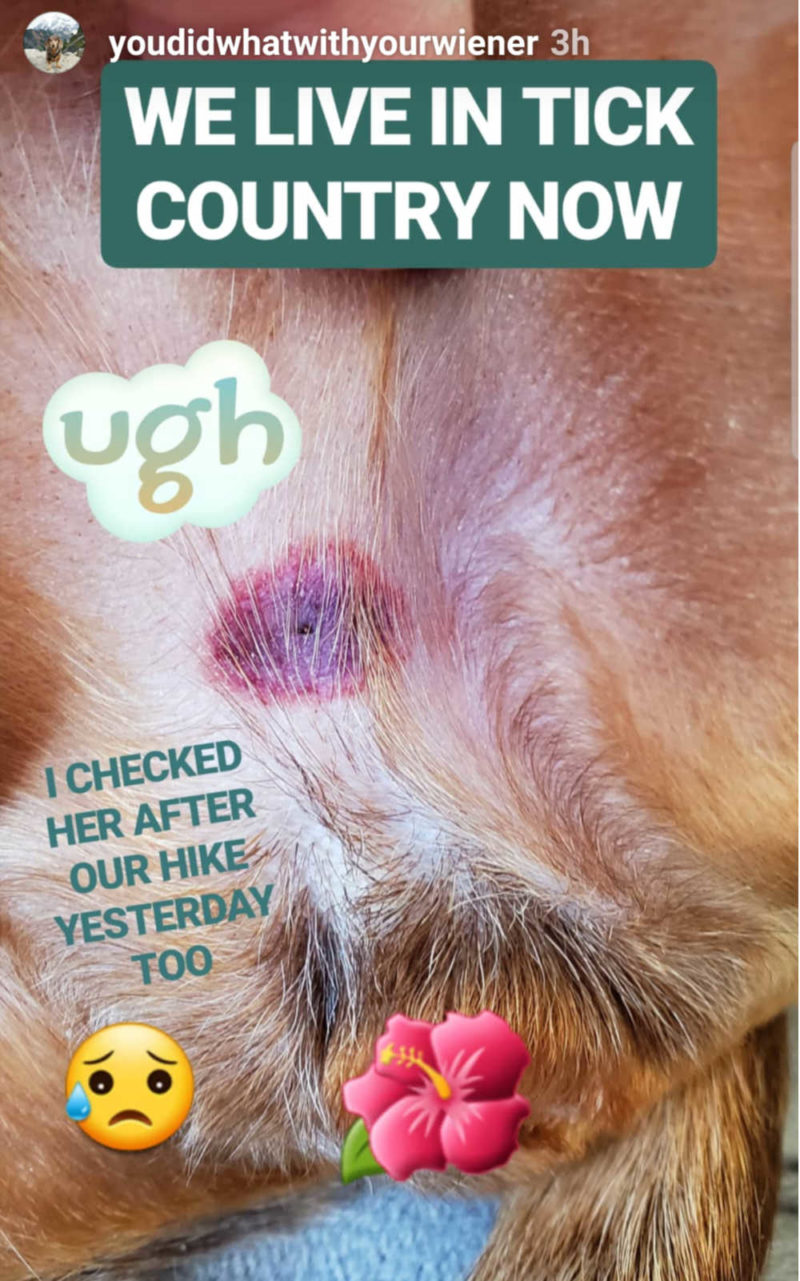
What kind of ticks are found in Spokane Washington?
Spokane, one of the largest cities on the east side of Washington State, is on the border of Washington and Idaho.
Specifically, the border of northern Idaho.
So you may be wondering if there are different ticks found in Spokane than the rest of Washtinton state because they have migrated from Idaho.
Ticks found in northern Idaho are Rocky Mountain Wood Ticks, Brown Dog Ticks, and American Dog Ticks, and Western Blacklegged Ticks – the same ticks found in Washington State.
Since the ticks found in eastern Washington, where Spokane is located, and in northern Idaho, any ticks that migrate across the border are the same species as found in Washington State.
One interesting note is that the Spokane Regional Health District says,
“Blacklegged ticks (which transmit Lyme Disease) are not native to the Spokane area and do not live in Spokane County.”
Should I go to the vet if my dog has a tick?
Any time you have a health concern, please take your dog to the vet.
I am not a veterinarian and am only sharing information from research and personal experience here to help inform you.
As stated above, if you merely find a tick crawling on your dog (unattached), it’s not possible for that tick to spread disease and it’s easily removed with your fingers.
If the tick was only crawling around on my dog’s body, there would be absolutely no concerts and I would not take my dog to the vet.
If you find a tick attached to your dog, and this is your first experience, I do think taking your dog to the vet can be helpful.
Your vet can talk to you about the current cases they are seeing in Washington State, and general risks of tick bites for your dog, to ease your mind.
They will also instruct you what signs and symptoms of tick-borne diseases to look out for.
Once you have been through this experience once, you may decide a vet visit is not necessary every time your dog is bit by a tick.
Just remove it and keep it in the freezer in case your dog starts to act sick so the tick can be sent in for testing.
What if I try to remnove the tick but I don’t get it all?
This happened to me when I tried to remove a tick from my dog with tweezers when it wasn’t engorged.
I paniced at first but it turns out that it’s not a huge deal.
Read this article to find out what happened, and what I learned, when the tick head got stuck in my dog.
How is Lyme disease in dogs treated?
Once your pet has been diagnosed with Lyme disease, it can be treated with oral antibiotics that are administered daily for a period of 4 weeks.
If your dog is also experiencing joint pain, your veterinarian may prescribe an anti-inflammatory.
If the disease has progressed to the point of causing kidney damage, more powerful antibiotics might be necessary, and hospitalization can be required.
Final Thoughts About Dogs and Ticks in Washington State
Ticks are gross and you should do everything you can to prevent them from getting on and biting your dog.
The only way to guarantee your dog doesn’t get an illness or disease from any tick that gets on them is to remove it before they bite.
Ticks are not a major issue in Western Washington so you don’t need to worry as much about them there. Fleas are a way bigger issue in Western Washington.
You may want to use a preventative on your dog if you live or spend time in Western Washington for that reason, especially spring through late fall.
Coincidentally, most flea repellents also treat ticks so you would be covering both bases.
Ticks are definitely more of a problem in central and eastern Washington.
During tick season, it’s best to take all of the precautions you can to prevent ticks and tick bites.


About the Author
Hi, I’m Jessica. I’ve been studying the Dachshund breed since 2007, owned 3 of my own, and shared in the lives of thousands of others through their owner’s stories. When I’m not sharing what I know on this blog, you can find me hiking, camping, and traveling with my adventurous wiener dogs.

Historically, ticks have only been a problem for those who resided on the eastern half of Washington State, but that has changed in the past decade.
Yes, that is what my article points out. I grew up in Western Washington and ticks were never an issue until about 10 years ago.